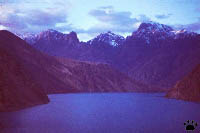
Sarez Lake, Pamir, Tajikistan
Fighting butterfly poachers
International insect trade is a little-known, but environmentally
destructive business. Each year, hundreds of thousands of butterflies, moths and
beetles are caught in many countries and sold to private collectors in the West,
mostly in Germany. Gangs of professional butterfly hunters organize expensive
expeditions, sometimes hire local people, and use all possible methods of collecting
their target species in large numbers. They use special sources of ultraviolet
light, chemical baits, and sometimes cut down large trees to get caterpillars
from the forest canopy. Their activities attract little attention, because in
Third World countries only large animals are generally considered to be in need
of protection. The more rare is the species, the higher is the market price; so
a butterfly can be hunted into extinction within just a few years. Some of the
poachers make special efforts to hunt a species to complete extinction - in this
case, the price for each specimen will be astronomical. |
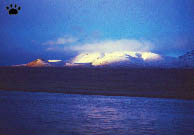
Lake Zorkul on Tajikistan/Afghanistan
border,
Southern Pamir Mountains | After the collapse of the Soviet Union, the mountains
of Central Asia became the prime target for butterfly hunters. Here the most prized
genus, Parnassius, reaches its highest diversity (Colias and other
genera are also looked for). Some species form local races on almost every mountain
range. Up to 50 groups of Russian, European and American hunters enter the area
every summer despite occasional guerilla activity, economic chaos and high crime
levels. |
| Although local authorities are generally aware of
ongoing poaching, there is little they can do to stop it. Many rare subspecies
are known only to people who hunt or collect them - their habitats and habits
are a tightly-kept commercial secret. Getting to some locations requires hiring
a helicopter, which is a problem for cash-starving local governments. It is very
difficult to prevent smuggling of such small objects as tiny insects. Professional
poachers are tough people, excellent mountaineers, and they try to make friends
with local warlords and drug smugglers (which is usually the same). |
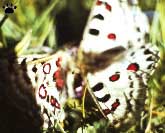
Couple of Parnassius tjanshanicus,
Transalay Range, Kyrgyzstan |

Our camp on an alpine meadow,
Pamir Mountains, Tajikistan | We conducted a number of expeditions to Central Asia
to gather information about endangered butterflies and poaching. Finding them
is an enormous challenge. Some isolated populations number less than 100 insects
and inhabit less than 1 sq. km of rocks above snowline. Certain species fly only
for a few days once in two years, and the exact dates shift from year to year.
Sometimes gangs of poachers are secretly followed by others and then shot. There
is a lot of espionage, electronic bugging, and other James Bond-style activities
in this business. Once I even wrote a small movie script
about all this. |
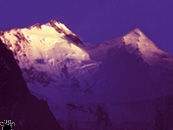 | 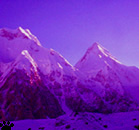 | 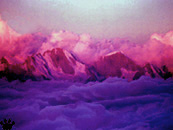 | | Mountain peaks of Central
Asia, left to right: Communism Peak, Pamir (7495m/25,000'); Khan Tengri, Tien
Shan (7003 m/23,360'); Beluha, Altai (4506m/15,120') |
| High, Tibet-like plateau of Eastern
Pamir shelters many isolated populations of Parnassius charltonius - the
most beautiful butterfly in Central Asia. Most of endangered subspecies there
survive on tiny rocky hills, formerly nunataks above the ice shield that had covered
the plateau during the Ice Age. These rocks can be reached by car or horse from
the paved Pamir Highway, so local butterflies are extremely vulnerable. The population
of P. charltonius anjuta consists of less than 50 insects, has a habitat
of 600 sq. meters (6000 sq. feet), and can be reached from a dirt road by a one-hour
hike. |
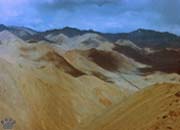
Pamir Highway in the mountains
of Eastern Pamir, Tajikistan |

Muztagata, Eastern Pamir, China | Sometimes butterfly hunters cross the borders to smuggle
rare insects from Afghanistan or China. Although most of Central Asian countries
try to protect their species, in most cases they have no information about newly-discovered
populations. In the former Soviet republics, efforts of local officials in charge
of Nature protection are often limited to charging fees and/or bribes for catching
insects or taking them out of country. |
| Unlike Eastern Pamir, Western Pamir (Badakhshan) is
a very difficult place to travel. Its high ridges and deep gorges are sometimes
almost impenetrable. Each valley is inhabited by its own ethnic group, and has
its own unique climate and vegetation. Although poachers do visit the area, local
butterflies are less vulnerable, because their populations are usually larger
and more difficult to reach. |
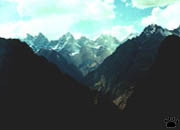
Western Pamir near
Tajikistan/Afghanistan border |
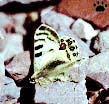
Parnassius charltonius
lyudmila, somewhere
in Central Asia | I am one of less than five people who have seen this
butterfly, named after my friend's wife. These creatures fly once in two years
in a remote place in Central Asia, where they inhabit a small rock face and an
ajacent talus slope. It takes five minutes to walk across their entire habitat.
I hope no one will see them within the next few decades, while butterfly collectors
still exist. We keep the location secret, of course. Although it is very difficult
to get there, the possible award is so high. If we let a word out, this subspecies
would likely become extinct in 3-5 years. |

Habitat of P.
apollonius,
Kazakhstan. | 
Pupa of P.
schtaudigeri,
Northern Pamir. | 
Larva of P. charltonius,
with an egg of a parasitic fly,
Northern Pamir. | 
Pupa of P.
charltonius,
Northern Pamir. | | Few people have ever tried to study the ecology and life cycle of high-altitude
butterflies. Their larvae and pupae are mostly hidden under stones, and can be extremely difficult to find.
Raising adults from larvae is almost impossible. |
| 
The habitat of
P.charltonius
lyudmila, Asia. |
| The most famous location in Central Asia is Sarez,
the World's most beautiful lake. It was formed in 1910, when an earthquake-caused
rockslide dammed Bartang River in Central Pamir. The lake eventually reached 70
km (40 miles) in length, and 1 km (.6 mile) in depth. All villages in the area
were either destroyed by the slide or inundated, so the entire country now belongs
to wildlife. Here one of the World's rarest butterflies, Parnassius autocrator,
lives on almost vertical slopes. |  |
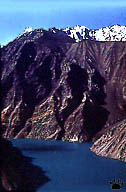
Lake Sarez, Tajikistan |

Helicopter taking off to
its 4-hrs flight
to Sarez Lake via
Bartang Narrows.
Rushan, Tajikistan | 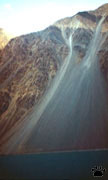
As a young lake, Sarez
has no real coastline.
It
takes you 6 hours to
climb such a slope, and
6 minutes to "ski" down. | Getting to Sarez isn't easy. Doing it without a helicopter
requires an expedition so logistically complete, technically difficult and dangerous,
that no people have done it since the beginning of Civil War in Tajikistan. If
you manage to get a helicopter, you'd also need a pilot with many years of Western
Pamir experience. Bartang Gorge is the third deepest in the World (after Kali
Gandaki in Nepal and Colca in Peru). In some parts it is so narrow that you can
throw a stone across. There is always a possibility of being killed by a missile
from some of the villages along the route. Finally, there are only three spots
for landing near the lake, and they are in the mouths of very windy canyons. |
| Despite all
difficulties, butterfly hunters sometimes manage to reach the lake. They catch butterflies on rock
faces and moving talus slopes, and casualties are an everyday routine in such
expeditions. Parnassius autocrator, P. charltonius, and also P. loxias from China/
Kyrgyzstan border are each associated with stories of serious injuries and deaths. |

Natural dam of Lake Sarez. |
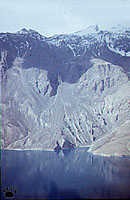
"Shoreline" of Sarez |

View of Fan Mountains
from Gissar Mts., Tajikistan. |

Tajikistan/Afghanistan border
along Pyanj River. |
Smaller species,
like P. simo, which fly very high above snow line, feeding on almost microscopic plants, do
not require rock climbing, but frostbites and acute altitude sickness are common among people looking for
them. |
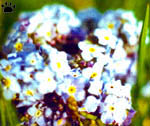
Primula - feeding plant of adult
P. tjanshanicus, Kyrgyzstan. | 
Sedum - feeding plant of larvae and
adult P. apollo, Buryatia. | 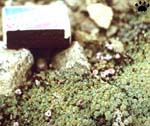
Microsaxifraga - feeding plant of
adult P. simonius, Kyrgyzstan. |
| Local officials usually pay little attention to poachers,
unless they see a chance to charge somebody for something. To get from Kyrgyzstan
to Pamir, you have to pay fees at 32 checkpoints; most of these fees are openly
"unofficial". Only in 1999 we finally got some Tajikistan officials to arrest
a group of butterfly poachers (the fact that they were also smuggling opium helped
a lot). In a shooting that accompanied the arrest, few people were killed; others
had to escape to higher elevation, where they froze to death next night. 120 kg
of opium and more than 3000 butterflies were confiscated (an subsequently disappeared). |

Lake Iskanderkul,
Tajikistan. |
 |  |  |  |  |  |  | Parnassius butterflies of Asia, top row, left to right:
P. loxias, P. delphius, P. charltonius, P. cardinal, P. simo, P. brehmeri;
bottom row, left:P. apollo, right:P. eversmanni (photos by A. Sochivko),
middle: P. autocrator (photo by L. Kaabak). Not to scale.
 |  |
Page 2
Home |